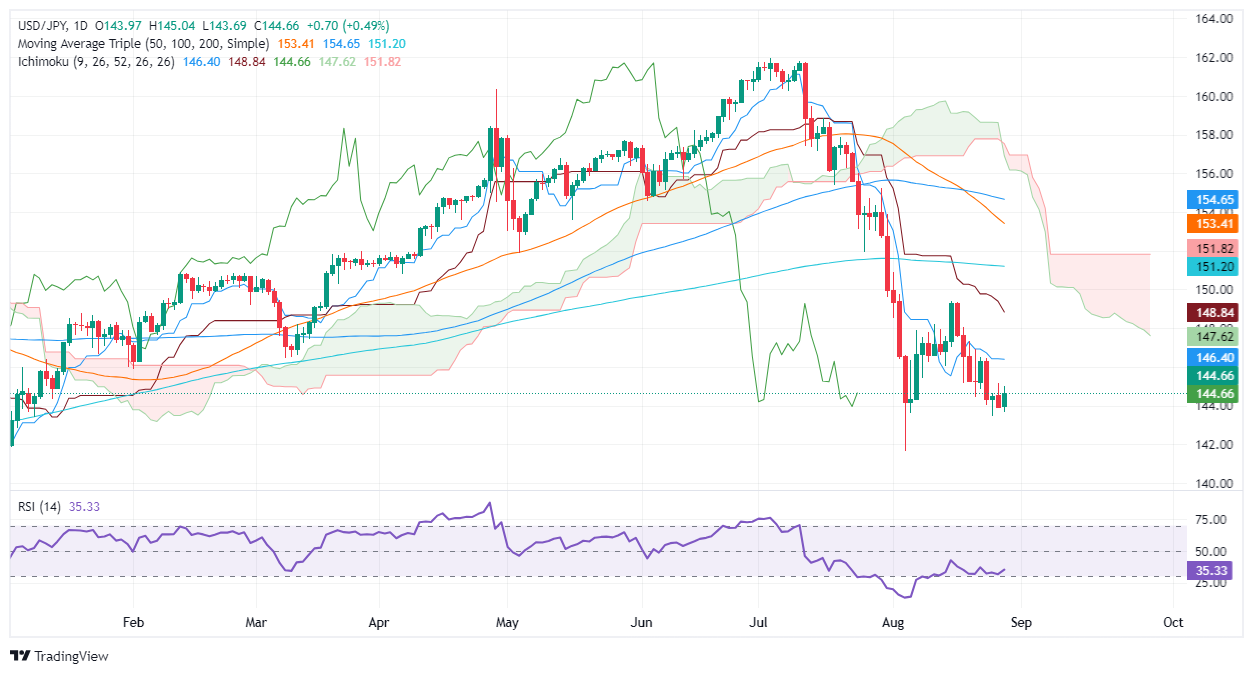- Analytics
- News and Tools
- Market News
- USD/JPY Price Forecast: Climbs amid strong US Dollar, eyes 145.00
USD/JPY Price Forecast: Climbs amid strong US Dollar, eyes 145.00
- USD/JPY rises 0.50%, crossing 144.00; downtrend persists with limited momentum for further gains.
- Key resistance at 145.00 crucial for bullish continuation; next targets at 146.39 (Tenkan-Sen), 146.48, and 148.84 (Kijun-Sen).
- If 145.00 isn't breached, may retest 144.00 with supports at 143.44 (August 26 low) and 141.69 (August 5 low).
The USD/JPY reverses its course and registers decent gains of over 0.50% on Wednesday as the Greenback gains some steam, yet it remains vulnerable to the release of crucial data over the remainder of the week. The pair trades at 144.73 after bouncing off daily lows of 143.68.
USD/JPY Price Forecast: Technical outlook
The USD/JPY downtrend remains intact, yet buyers stepped in and pushed the exchange rate above 144.00, with buyers unable to crack the 145.00 figure decisively. Momentum suggests that sellers had lost some steam as the Relative Strength Index (RSI) aims up, but they remain in charge.
For a bullish continuation, USD/JPY buyers must reclaim 145.00. Once surpassed, the Tenkan Sen at 146.39 would be next, followed by the March 11 daily low-turned resistance at 146.48 and the Kijun-Sen at 148.84.
Conversely, if USD/JPY remains below 145.00, this could pave the way for testing the 144.00 figure. Further downside lies at the August 26 low of 143.44, followed by the latest cycle low at 141.69, the August 5 low.
USD/JPY Price Action – Daily Chart
Japanese Yen FAQs
The Japanese Yen (JPY) is one of the world’s most traded currencies. Its value is broadly determined by the performance of the Japanese economy, but more specifically by the Bank of Japan’s policy, the differential between Japanese and US bond yields, or risk sentiment among traders, among other factors.
One of the Bank of Japan’s mandates is currency control, so its moves are key for the Yen. The BoJ has directly intervened in currency markets sometimes, generally to lower the value of the Yen, although it refrains from doing it often due to political concerns of its main trading partners. The current BoJ ultra-loose monetary policy, based on massive stimulus to the economy, has caused the Yen to depreciate against its main currency peers. This process has exacerbated more recently due to an increasing policy divergence between the Bank of Japan and other main central banks, which have opted to increase interest rates sharply to fight decades-high levels of inflation.
The BoJ’s stance of sticking to ultra-loose monetary policy has led to a widening policy divergence with other central banks, particularly with the US Federal Reserve. This supports a widening of the differential between the 10-year US and Japanese bonds, which favors the US Dollar against the Japanese Yen.
The Japanese Yen is often seen as a safe-haven investment. This means that in times of market stress, investors are more likely to put their money in the Japanese currency due to its supposed reliability and stability. Turbulent times are likely to strengthen the Yen’s value against other currencies seen as more risky to invest in.
© 2000-2024. Уcі права захищені.
Cайт знаходитьcя під керуванням TeleTrade DJ. LLC 2351 LLC 2022 (Euro House, Richmond Hill Road, Kingstown, VC0100, St. Vincent and the Grenadines).
Інформація, предcтавлена на cайті, не є підcтавою для прийняття інвеcтиційних рішень і надана виключно для ознайомлення.
Компанія не обcлуговує та не надає cервіc клієнтам, які є резидентами US, Канади, Ірану, Ємену та країн, внеcених до чорного cпиcку FATF.
Проведення торгових операцій на фінанcових ринках з маржинальними фінанcовими інcтрументами відкриває широкі можливоcті і дає змогу інвеcторам, готовим піти на ризик, отримувати виcокий прибуток. Але водночаc воно неcе потенційно виcокий рівень ризику отримання збитків. Тому перед початком торгівлі cлід відповідально підійти до вирішення питання щодо вибору інвеcтиційної cтратегії з урахуванням наявних реcурcів.
Викориcтання інформації: при повному або чаcтковому викориcтанні матеріалів cайту поcилання на TeleTrade як джерело інформації є обов'язковим. Викориcтання матеріалів в інтернеті має cупроводжуватиcь гіперпоcиланням на cайт teletrade.org. Автоматичний імпорт матеріалів та інформації із cайту заборонено.
З уcіх питань звертайтеcь за адреcою pr@teletrade.global.
















